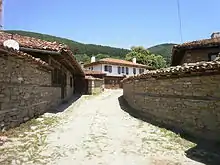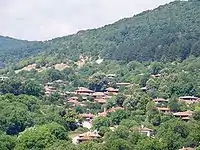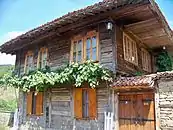Zheravna
Zheravna (Bulgarian: Жеравна [ˈʒɛrɐvnɐ]) is a village in central eastern Bulgaria, part of Kotel municipality, Sliven Province. The village, set in a small valley at the southern foot of the eastern Balkan Mountains, is an architectural reserve of national importance consisting of more than 200 wooden houses from the Bulgarian National Revival period (18th and 19th century), and a quickly developing tourist destination.

The village emerged between the 12th and 14th century and grew to become a cultural and handicraft centre in the 18th century. As the local population came to wealth, the architectural appearance of the village was shaped by one- or two-storey wooden houses surrounded by stone walls and cobblestone alleys.
Popular sights in the village include the museum house of the merchant Rusi Chorbadzhi from the early 18th century, the Church of St Nicholas inaugurated in 1834 and housing icons from the 18th and early 19th century, the museum house of the noted writer Yordan Yovkov born in 1880, the art gallery occupying the old class school and the museum house of the educator Sava Filaterov.[1]
As of September 2005 the village has a population of 460. Zheravna is at 579 m above sea level.
Geography

Zheravna is situated in the middle part of Stara Planina in the Municipality of Kotel. The territory of Zheravna covers an area of 5,000 m2 with an average altitude of 650 meters. The terrain is mountainous, and there is also a valley, crossed by wooded hills. The highest peak, which is located 6 km west of the village, is Razboyna - 1128 meters above sea level. The natural resources of Zheravna consist mostly of strangely shaped rock formations, mysterious cave complexes, diverse flora and fauna. Zheravna is rich in water resources. Springs and rivers are supplied by rain and melting snow. Zheravna is rich in forest vegetation. Both deciduous and coniferous trees are common. Animal diversity is great and includes wild boar, roe deer, red deer, jackal, wolf, rabbit, quail, partridge and others. The climate in Zheravna is a typical mountain climate with early autumn, late spring and very cold winter. 57.5% of the days in the year are windless. Winter winds are strongest and reach average maximum speed 3.3 m/s. The air is clean and dry. The Zheravna environment can be defined as an ecologically clean area as there is no industry in the town and is away from big cities.
History
Once this place was an old tracian village called Potuka (and now there is an area in Zheravna called Potuka). There are several versions for the origin of the name of the village. One is that it comes from the bird crane (in Bulgarian 'zherav'), which is highly unlikely, because cranes never land in the area. Another, a more plausible, one is that it comes from "zherna", "zherka", "jerkov" - words with old Slavic root meaning 'watermill'. In the area there are many mills.
In the last few centuries Zheravna had been called Zheruna but after the Liberation of Bulgaria in 1878, the name gradually changed into Zheravna. There were crafts, livestock and trade developed here. The village prospered in the 17th century because it was on the main road to the old capital of Tarnovo. The rooms of the houses have carved ceilings and exquisite decoration on the doors, windows and iconostases. Today, the old school is turned into a gallery, and a lot fountains and old mills are preserved. There were schools of carving in the town.
Tourism and Places of Interest
Zheravna is an easy location to travel to, situated 32 km from the Petolachkata junction on the road from Sofia to Burgas. The distances to the cities of Sliven, Burgas, Varna and Sofia are respectively 48, 110, 184 and 333 km. There are many uninhabited houses in Zheravna. Much of the uninhabited houses were bought and restored, in order to attract tourists and they are categorized as guest houses. Each year, Zeravna is visited by about 20,000 tourists. Most of the houses in Zheravna were built during the Bulgarian Revival, but their inner interior has been since renovated. The Saint Nicholas Church was built in 1834. It was originally painted by master painters Jordan Mihajlovic from Elena and Georgi and Gencho from Tryavna. Today the church is adorned with a rich collection of icons, stone sculptures and church plates. The icons are dated from the second half of the 18th and the early 19th century. Zheravna is a heritage site. Today, there are nearly 200 houses registered as monuments of culture, each of them built some 150 to 300 years ago. During the Revival, Zheravna became a major cultural center. The village took an active part in the resistance against Ottoman rule and participated in the April Uprising. The times of the village Revival period is preserved in the local museums: the House of Sava Filaretov; the Home of Yordan Yovkov, the St. Nicholas Church, the Old school - now an art gallery; the House of Rusi Chorbadzhi. Close to Zheravna is the town of Kotel with its Natural History Museum; Galatan school; Kyorpev house; Museum of the Revival; and the village of Medven where House of Zahari Stoyanov is.
People born in Zheravna
Rusi Chorbadzi was a wealthy landowner and master in Zheravna and later a mayor. He was one of the richest men in the village, had some 30,000 sheep and was trading with the Turks and the Greeks. When the kurdzhalii came to the village, he devised a plan to hide all the village girls in the woods, for which he and he two sons were murdered by the vagabonds. The house of Chorbadzi is a museum now and it narrates the life of Rusi – a wealthy man involved in the governance of the village. The original openwork carvings above the doors in the framework of the cupboards are Impressive.
- Georgi Bonchev (1866-1955), geologist
- Boncho Georgiev (1849-1899), merchant and owner of the animal shop for meat. He was mayor after the Liberation
- Petar Dimitrov (1848-1919), diplomat
- Todor Ikonomov (1835-1892), politician
- Yordan Yovkov (1880-1937), writer
- Anna Nyagulov, author of "genetic memory of Zheravna"
- Rhino Popovic (1773-1858), teacher and writer
- Sergei Todorov (1896-1974), a former mayor of Varna
- Russi Chorbadji gaffer and mayor at the end of the 18th century
- Vasil Stoyanov (1839-1910), philologist
- Sava Filaretov (1825-1863), educator
- Nikolay Dimitrov (1919-1993), a mayor and politician contributed to preserving the look of the village Zheravna
- Rayu Topalov (1908-1990) founder of museums in Zheravna
- Ivan Raev (1935-1978) actor, director, writer
- Eng. Vasil Rankov (1874-1950), founder of the pioneer (engineer) troops in Bulgaria.
- Ivan Tsankov (1840-1925), Bulgarian revolutionary.
Honours
Zheravna Glacier on Greenwich Island in the South Shetland Islands, Antarctica is named after the village.
References and notes
- Bousfield, Jonathan (2002). Rough guide to Bulgaria. Rough Guides. p. 307, 308. ISBN 978-1-85828-882-6.
Gallery





 Hand made rugs from Zheravna
Hand made rugs from Zheravna
External links
| Wikimedia Commons has media related to Zheravna. |